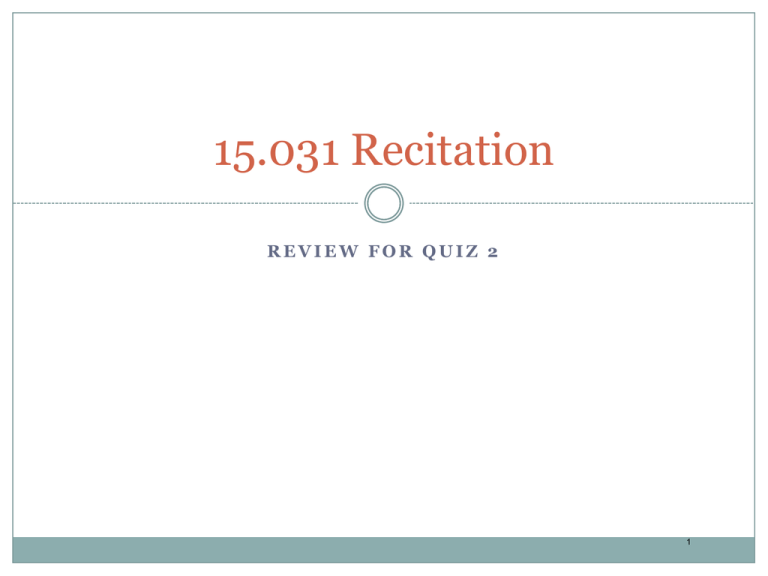
15.031 Recitation
REVIEW FOR QUIZ 2
1
Summary
Firm Strategy
Investment Decisions and Business Models
Non-Renewable Resources
Hotelling Theory and Shale
Electric Power Systems
Today’s System and the Future
Making Public Policy
Social Movements
Environmental Regulation
2
Firm Strategy
NPV analysis v. strategy
Be skeptical of positive NPV proposals
Strategy for sustainable advantage, fit and complementarities with projects
Industry attractiveness v. niches – Porter’s five Forces
Types of Strategy
Low-cost versus Quality / Differentiation
Husky: past strategy, current challenges
• Further increase buyer WTP
•
R&D, service, etc.
•
How much more room?
• Improve cost position
Cut perks, salesforce, etc.
Implications for delivering on high WTP?
Cut margins/prices
• Go after other segments
Consistent with cost structure, culture, etc.?
• Big challenge: package of changes should fit with each other, existing activities
3
Non Renewable Resources
Production Planning
Classic Hotelling Theory
Owners of non-renewable resources will only produce a supply of their product if it will yield more
than instruments available to them in the market (specifically bonds and other interest bearing
securities)
What does this assume?
Owners of non-renewable resources are motivated by profit
Markets are efficient
Why is this useful?
Helps economists predict the price of oil and other non-renewable resources
What do you make of this?
If oil prices rise at prevailing interest rates, there would be no restrictions on supply
If oil prices rise faster than prevailing rates, there’s no incentive to produce today
Reasons Hotelling doesn’t hold
4
Electric Power Systems
Output largely not storable
Time varying and unpredictable demand
Capacity variation and mixing technologies
Base load and peak load plants – costs & benefits
Environmental
Economic –
Transmission and Distribution
Natural monopolies, inefficient to have multiple systems
Problems with natural monopolies, solutions
State Regulation and Market Centric Model
Grid Architecture
Tree & Mesh Structure
Smart Grids
Retail prices, time varying nature of costs
New Technologies
5
Economic Analysis of a multi-technology system
Cost Analysis
Load Duration Curve, Optimal Mix
•
•
•
Graph of 2008 supply curve for lower 48 NERC
regions removed due to copyright restrictions.
varying demand => varying
marginal cost
Peak loads versus base loads
Dynamic pricing vs. /kWh pricing
© The National Grid Company. All rights reserved. This
content is excluded from our Creative Commons license.
For more information, see http://ocw.mit.edu/fairuse.
•
•
•
Generally base-load plants run flat out when they
run; other plants can more easily vary output to
follow load
Consider two plants with equal capacities: If you
plan to run < H* hours, the peaker is cheap
Many technologies, costs: “economic dispatch” =
turn on lowest marginal cost units first
6
Making Public Policy
Politics versus Economics – How they differ and why they are both needed
Politics as competition among interest groups – Madison & Lowi, Alternative models – Klein, Whitt
•
Madison: Faction: “a number of citizens … who are united and actuated by some common impulse
of passion, or of interest, adverse to the rights of other citizens or to the permanent and aggregate
interests of the community”
•
•
factions are inevitable, but if they are all small & weak, none can dominate competition among them-
Lowi: such competition among interest groups has become both an accepted description of US
politics and, implicitly, an ideal – “interest group liberalism” – K Street.
Lowi on Madison
the only way to do that and to be sure that it and the true self-regulatory character of pluralism can be institutionalized is
to keep group interests in constant confrontation with one another in Congress. Once an agency is "depoliticized" or
"made independent" by handing it over to its organized clientele, the number of "factions" is reduced from a competitive
to an oligopolistic situation
Social Movements
How they come about and differ from interest groups & political parties
How they influence markets and policy
7
U.S. Environmental Regulation
EPA Regulation
US Clean Air act of 1970
Treatment of new and old sources
Implications
1990 Acid Rain Program
Why it was enacted
Implications
Economic Analysis
•
Incentive to prolong the life of old sources
•
Variation in clean-up costs and cost of standard setting - Clean areas resisted scrubbing, national electricity tax and
Dirty areas resisted cleanup
•
National cap-and-trade (“allowance trading”)
•
Other environs held their noses; no alternative way forward
Allowance allocations were used to build a coalition
Small part of big clean air bill
Once passage seemed likely, wild scramble for allowances
Took effect in 1995, on schedule, and Acid Rain declined
8
Economic Analysis
Cap and Trade
Not a great surprise when you think about it;
short-run demand inelastic, supply perfectly
inelastic, but bothers both industry and environs.
Taxation
A tax would have given price stability but
quantity risk (environs hated) and greater
burden on utilities (they hated)
9
The 1990 Acid Rain Program
12
500
450
Counterfactuals
10
400
Million tons SO2
350
300
Marginal Cost of Abatement
250
200
SO2 Emissions
8
The Cap
6
4
150
Price
100
2
Scarcity Rent
50
Cost
0
0
0
5
10
15
20
25
30
35
40
45
50
55
60
65
70
75
Cap
80
85
90
95
100 105
BAU
Emissions
110
115
1985
120
Note: Marginal Cost curve is Demand for
Allowances curve, normalized to 100 at Price = 0
•
•
•
1987
1989
1991
1993
1995
1997
1999
2001
2003
2005
2007
2009
Standards always have an incentive to cut, no
matter how clean
Produced considerable innovation: e.g., coal
blending, cheap scrubbers
SO2 prices moved more than some expected
Source: U.S. Environmental Protection Agency. “Acid Rain Report: 2003 Progress Report.” September 2004.
10
Final Papers
10 minutes per team
Format: 5-6 minutes presentation (max. 3 slides),
then 4-5 minutes to answer questions
2 people to present, other 2 to take questions
Other Questions?
11
MIT OpenCourseWare
http://ocw.mit.edu
15.031J / 14.43J / 21A.341J / 11.161J Energy Decisions, Markets, and Policies
Spring 2012
For information about citing these materials or our Terms of Use, visit: http://ocw.mit.edu/terms.

